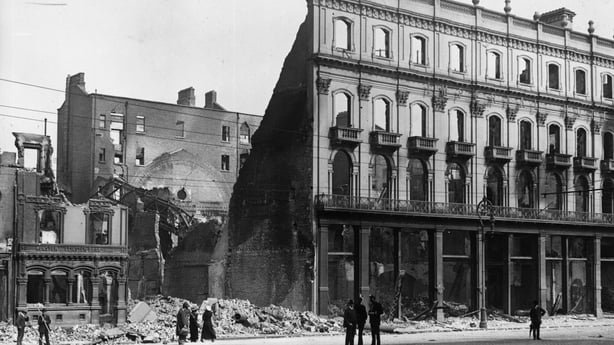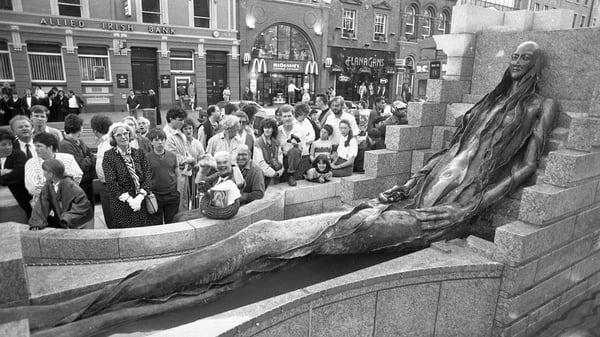Analysis: one of the mainstays of city life for over 170 years, the store's iconic clock provided a meeting place for generations of Dubliners
This article is now available above as a Brainstorm podcast. You can subscribe to the Brainstorm podcast through Apple Podcasts, Stitcher, Spotify or wherever you get your podcasts .
Clery's clock is again to be seen on O'Connell Street following its restoration and unveiling by Dublin's Lord Mayor, in preparation for the store’s reopening after eight years of closure. One of the principal institutions dominating Sackville (O’Connell) Street in the 19th and 20th centuries, the iconic store was famous with shoppers and those seeking love and adventure. It was mentioned three times in James Joyce’s Ulysses and, if that was not illustrious enough, much admired by Charles Dickens.
But the return of the clock is an ideal time to remember the origins of Clery’s. The store arrived on Sackville Street in 1853 amidst great controversy as small retailers objected to the arrival of the 'department store’. In the early 19th century, a trend of converting multiple retail units or former houses into larger establishments became commonplace.
Sackville Street, a relatively new and popular commercial street in the city, was at the forefront of these retail trends. Following the opening of the Burlington Arcade in London in 1819 similar enterprises began appearing in Dublin. Shopping arcades such as the Sackville Street Bazaar arrived in the 1820s, offering shoppers a chance to browse multiple shops and coffee houses within a single shopping arcade. Similarly, Richard Allen’s Drapery shop opened up all of its floors to different clothing departments, while maintaining multiple in-house tailors at 28 Lower Sackville Street.
We need your consent to load this rte-player contentWe use rte-player to manage extra content that can set cookies on your device and collect data about your activity. Please review their details and accept them to load the content.Manage Preferences
From RTÉ News, Dublin landmark Clery's clock has been restored
In the 1830s and 1840s, various other department stores arrived on Dublin’s commercial streets, sparking yet more controversial debate regarding the threat these 'Monster Houses’ posed to the smaller retailer. Within this background, historians often claim McSwiney, Delaney & Co (the store’s original owners) to be the very first purpose-built department store in the world.
When the original building was constructed on Lower Sackville Street, it displaced several businesses and buildings. Due to their size, shape and class of building, they were possibly rare survivors from the earlier location of Drogheda Street, which had preceded Sackville Street. They included Nolan’s tobacconists, Walsh’s printers, Bird’s jewellers and Brady’s confectioners. The Imperial Hotel later became incorporated into the new building constructed in 1853.
Designed by architect William Caldbeck, the foundation stone of McSwiney, Delaney & Co’s New Mart was laid in 1853 under the guidance of the contractors; Messrs Beardwood & Son of Westland-row. The construction of the monster mart or department store was as ambitious in scale, as was its tight time frame for completion. McSwiney, Delaney & Co, the first owners, was a drapery firm that had enjoyed success in Cork and Clonmel. The firm was determined to have the store up and running in time for the Great Industrial Exhibition of 1853, which was scheduled to run from May to October that year.
We need your consent to load this rte-player contentWe use rte-player to manage extra content that can set cookies on your device and collect data about your activity. Please review their details and accept them to load the content.Manage Preferences
From RTÉ Radio 1's the Ray D'Arcy Show, Cork horologist Philip Stokes restored the Clery's clock and talks about his family's long connection with it
With just three months between laying the foundation stone and opening the exhibition, the work was cut out for the contractors. To attempt to adhere to this schedule, a 12–hour construction day was abandoned in favour of a rather ambitious 24 hour working day with rotating shifts. To facilitate working in the dark, enormous gas-fuelled jet lamps were installed to illuminate the construction site. Such a novelty within the city centre brought many onlookers to view the spectacle, particularly on the first night of construction when heavy snows halted work.
An onlooker from the Limerick Reporter captured the exciting first day, writing: 'Wednesday night they commenced the night work, and six immense jets of gas blazed brilliantly over the works, illuminating the street to a great distance, and giving abundant light to the masons and other artificers to proceed with their special avocations. The scene was very novel and, indeed, exciting, and, connected with the rapid growth of the building, gave a semi-magic air to the whole proceeding. The men continued to work by the brilliant light of the gas to an advanced hour of the night, when the coming on of a heavy shower of snow and sleet obliged them to knock off for the night.’
Miraculously, the store opened in May of that year. Its opulence was remarked upon in the press, which referred to the building as The Palace Drapery Mart. The well-travelled Dickens referred to the store as ‘A Palatial Drapery Establishment’ following his visit. The store also became one of the first large shops in Dublin to install electric lighting within, in 1892.
We need your consent to load this rte-player contentWe use rte-player to manage extra content that can set cookies on your device and collect data about your activity. Please review their details and accept them to load the content.Manage Preferences
From RTÉ Archives, fire breaks out in the basement of Clerys department store in Dublin (Broadcast 4 March 1971)
During the 1916 Rising it was utterly destroyed and in the subsequent compensation process, it was one of the largest recipients of a rebuilding award when £77,292 was granted to Clery & Co. for the destruction of 21-27 Sackville Street. The ‘New Clery’s’ was rebuilt, at a more sedate pace than that achieved by the first buildersm and the store reopened in 1922.
Throughout its lifetime, the store endured various successes and challenges. It faced several economic difficulties and changed names and owners multiple times, including Michael Clery, William Martin Murphy, Michael Guiney, and his wife Mary. Nonetheless, it is also best remembered as one of Dublin’s most popular social locations.

In the 20th century in particular, the store was associated with various galas, balls and dancing competitions. Its ballroom could host 500 people and historian Stephanie Rains has referred to the store as 'one of Dublin's most glamorous social spaces during the 1950s and 1960s'.
However, for Dubliners, under Clery’s clock will always be associated with romance and love. In the days before mobile phones, social media and the internet, it was a popular meeting spot for couples and friends. Such meetings — or not — are evocatively preserved in the lyrics of Under Clery’s Clock by Dublin band The Radiators:
We need your consent to load this YouTube contentWe use YouTube to manage extra content that can set cookies on your device and collect data about your activity. Please review their details and accept them to load the content.Manage Preferences
Under Clery’s clock tonight at eight
I want to wait, oh God he’s late
He’s stood me up
The next bus to An Láris his for sure
Ten minutes more I know
will bring my love to me
The love that does not have a name
Perhaps, as the clock comes into view again, the long-established meeting place will endure well into the 21st century. Only time will tell.
The views expressed here are those of the author and do not represent or reflect the views of RTÉ



